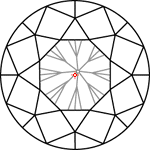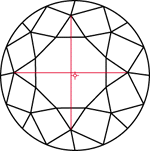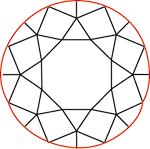Symmetry evaluation
When cutting a diamond, a cutter tries to make its shape regular, arranging all the cut elements into a symmetrical geometric pattern. The deviations of the actual shape from the regular geometric pattern detectable with a 10 x loupe are called symmetry deviations.
The GIA grading system differentiates major and minor symmetry features. For example, if the oval shape of the girdle outline is visible to the unaided eye, it is a significant symmetry deviation (major symmetry). If the oval shape is detectable only with a loupe, it is considered as minor symmetry. In the course of grading, a diamond is successively tested for all possible symmetry deviations, and, if any is found, relevant notes are made in the worksheet.
 |
Off-center culet
Abbreviation: Ñ/îñ
Observation method: face-up, at the right angle to the table. Shifting the culet off center is evaluated.
Grading: If the off-center position of the culet is visible to the unaided eye, the shift is considered major; if it can only be detected with a loupe, the shift is considered minor.
|
|
 |
Off-center table
Abbreviation: T/oc
Observation method: face-up, at the right angle to the table. Shifting the table off center is evaluated. The center of the table is not exactly beneath the culet.
Grading: If the off-center position of the table is visible to the unaided eye, the shift is considered major; if it can only be detected with a loupe, the shift is considered minor.
Important: There are two cases when the culet is not exactly beneath the center of the table: off-center table and off-center culet. If the table is off-center, distortion of the crown symmetry takes place; if the culet is off-center, distortion of the pavilion symmetry is established
|
|
 |
Out-of-round girdle outline
Abbreviation: R.G.
Observation method: face-up.
Oval shape and indentation can be established.
Grading: major or minor girdle distortion can be established depending on the degree of the deviation.
|
|
 |
Table and girdle plane are not parallel
Abbreviation: T/G
Observation method: stone is held table-to-culet and is rotated around its axis. The non-parallel position can be more or less evident depending on which side the stone is seen.
Grading: visible to the unaided eye - major feature; visible to the loupe-eye - minor feature.
|
|
 |
Wavy girdle
Abbreviation: WG
Observation method: stone is held table-to-culet and is rotated around its axis.
Important: it should not be confused with uneven girdle.
Grading: visible to the unaided eye - major feature; visible to the loupe-eye - minor feature.
|
|
 |
Not properly pointed facets
Abbreviation: PTG
Observation method: successive examination of a stone, facet after facet (face-up, face-down, and profile view).
Special attention: culet, edges with adjoining girdle facets, points of intersection of five and four facets
Grading: minor symmetry features.
|
|
 |
Crown and pavilion misalignment
When a diamond is observed from the side, the upper girdle facets must be exactly above the
lower girdle facets, and the upper edges must be exactly above the lower edges.
Grading: minor symmetry features.
|
|
 |
Misshapen facets
Abbreviation: Fac
Observation method: Successive evaluation of the table shape (deviation from the regular octagon is possible), star facets, bezel facets, upper girdle facets, lower girdle facets, and main pavilion facets.
Grading: minor symmetry features.
|
|
 |
Extra facets
Extra facets - facets which are not implied by a cut style.
1.Natural - a residue of the surface of the original diamond crystal. Natural is typically occurs in the girdle zone on either crown or pavilion side of the diamond. A natural often has an uneven surface. If a natural (or naturals) is small, is not seen when the diamond is observed through the table, or can be removed by repolishing, it does not affect the clarity grade and is only considered in symmetry evaluation (minor feature). |
 |
2.Extra facet -
made in the course of cutting. It has a polished surface and may occur on any side of the stone. If the extra facet does not affect clarity, it is referred to as minor symmetry feature. |
|









